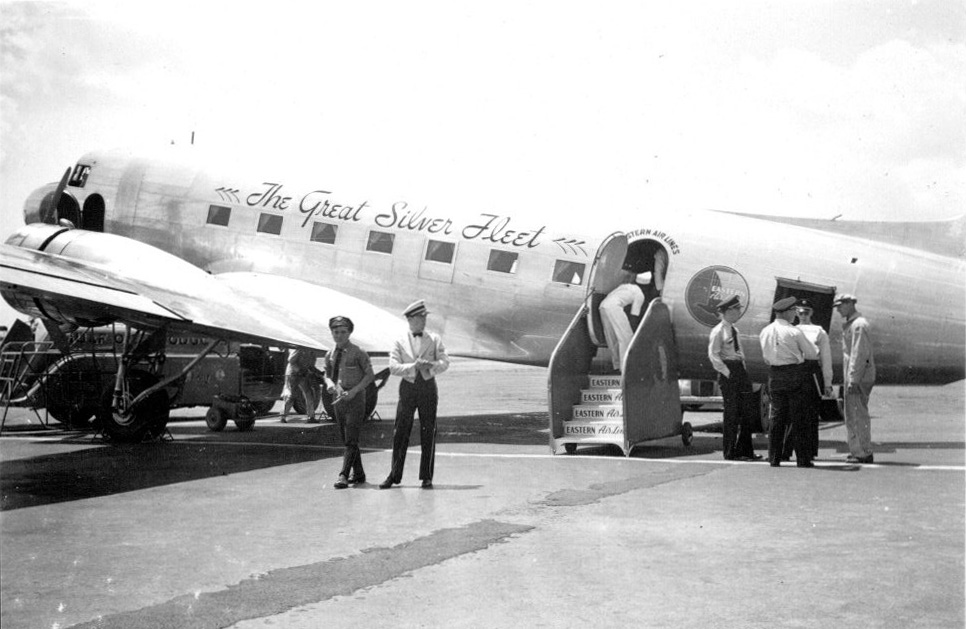The Uiver Memorial DC-2
Eastern Airlines “The Great Silver Fleet”
The DC-2-112 was one of 200 built by the Douglas Aircraft Co at Santa Monica in 1934. It was designated as serial no 1286 and delivered to Eastern Air Lines, New York as NC-13736.
Eastern Air Lines was a composite of assorted air travel corporations, including Florida Airways and Pitcairn Aviation, the latter established on April 19, 1926, by Harold Frederick Pitcairn, son of Pittsburgh Plate Glass founder John Pitcairn, Jr.
In the late 1920s, Pitcairn Aviation won a contract to fly mail between New York City and Atlanta, Georgia on Mailwing single-engine aircraft. In 1929, Clement Keys, the owner of North American Aviation, purchased Pitcairn. In 1930, Keys changed company's name to Eastern Air Transport, soon to be known as Eastern Air Lines after being purchased by General Motors and experiencing a change in leadership after the Airmail Act of 1934.
In 1938 World War I flying ace Eddie Rickenbacker bought Eastern from General Motors. The complex deal was concluded when Rickenbacker presented Alfred P. Sloan with a certified check for $3.5 million. Eastern Airlines was one of America’s most successful airlines. It ceased operations in 1991.

NC-13736 served as a passenger aircraft until it was purchased in 1941, along with ten other remaining DC-2s, by the British Purchasing Commission in the USA, on behalf of the Australian Government as there was a desperate need for large capacity transport aircraft by the Royal Australian Air Force.
In 1941 the aircraft was brought on RAAF charge as A30-11. It had been disassembled by Eastern Air Lines for shipping and was reassembled at Laverton No.1 Aircraft Depot in Victoria.
The DC-2 saw RAAF service with No.1 Service Flying Training School, No.1 Wireless Air Gunners School and as a transport vehicle. It crashed in 1945 at Parafield, SA during a forced landing, suffering major damage and was then considered useable only for components.
In October 1946, the airframe was sold to Sid Marshall of Marshall Airways, Mascot, NSW and put into storage.
See the full RAAF history of A30-11 here.
The dismantled aircraft was was sold to the West Albury Rotary Club in 1979.

The Rotary Club Albury West
In 1979 The Rotary Club of West Albury, many of whom were aviation enthusiasts, embarked on an ambitious project to purchase the derelict DC-2 from Bankstown, Sydney and restore it as a memorial to the Uiver Story as a part of the club’s 75th Anniversary.
The DC-2, purchased for $4,500 from Rotary’s fundraising activities, came from Sid Marshall, and was in a poor state, having been previously dismantled. The Rotarians had actively sought to find any available DC-2 and were aware that this was the oldest surviving Douglas commercial airliner in the world and worthy of restoration to become a significant Albury monument. Geoff Ross and Adrian Friday made the journey to retrieve the aircraft and returned with two semi-trailer loads, making an impressive sight as the large airframe made its unceremonious way down Dean Street to be housed in a shed on the causeway.
The temporary location allowed for the wings to be reattached and restoration completed over successive months. The wings then had to be disassembled again for its eventual relocation to Albury Airport. The Rotarians had arrived at a concept to display this massive aircraft on poles, as was a common trend in the ‘80’s as a way of displaying these important aircraft as prominent and permanent monuments. Many RSL clubs and rural communities have their own “plane on a pole” as a public monument in tribute to Australia’s Returned Soldiers. That the DC-2 was being used to commemorate a significant civilian event, prior to WWII, as well as being recognised for its military history, adds to its unique significance as a memorial.
The working group managed to raise this large aircraft onto three poles, located just to the east of the Airport Terminal. A memorial wall and garden were built at the base, with the Uiver story immortalised. The monument was officially dedicated on Sunday, 2nd March, 1980 by Sir Zelman Cowen the Governor General of Australia, with the Albury Mayor, Alderman John Roach. The Uiver Memorial became a distinctive landmark for all those flying into the town, an awe-inspiring “sculpture” that many tourists and locals came to identify with Albury for 20 years.
© Copyright Uiver Memorial Community Trust 2012-2018.
Site provided by Ian Cossor Design. Hosting kindly donated by Coxtech.








